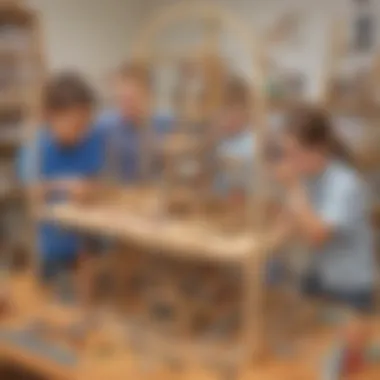Innovative STEM Activities for Fourth Graders


Intro
In today’s educational landscape, integrating STEM (Science, Technology, Engineering, and Mathematics) into the curriculum for fourth graders is more than a trend; it's a necessity. As children approach the upper elementary grades, their need for engaging, hands-on experiences becomes crucial. These experiences not only build foundational knowledge but also foster important skills such as problem-solving and critical thinking. The activities we will explore here aim to nurture intellectual curiosity while making learning enjoyable.
The focus on STEM education at this age can have lasting impacts. Not only do these activities help solidify academic concepts, but they also prepare children for the complexities of the modern workforce. Through practical applications, teachers and parents can inspire a lasting passion for discovery and innovation.
Interactive Learning Games
Digital and physical games serve as effective tools for enhancing learning. Below, we delve into the realm of interactive games tailored for fourth graders.
Popular Games
Many games capture the attention of fourth graders. Among them are:
- Minecraft: Education Edition
- CodeCombat
- Kahoot!
- Mathletics
These games not only entertain but also educate, striking a balance between fun and learning.
Description of Top Educational Games
Minecraft: Education Edition combines creativity with coding, promoting spatial awareness and teamwork.
CodeCombat introduces simple programming through a game-based platform, allowing kids to learn coding concepts in an interactive environment.
Kahoot! transforms assessment into an engaging quiz format that captivates learners, making review sessions something to look forward to.
Mathletics, on the other hand, challenges students with math puzzles that adapt to their individual skill levels.
Benefits of Playing Educational Games for Kids' Cognitive Development
Playing educational games positively influences cognitive skills. Research shows that such games:
- Improve memory retention
- Enhance problem-solving abilities
- Foster strategic thinking
- Encourage collaboration and communication
"Interactive games can act as a vital bridge between traditional teaching methods and the desire for immersive learning experiences in today's children."
Game Reviews
Minecraft: Education Edition is highly praised for its versatility. Users appreciate its user-friendly interface and robust community support.
CodeCombat offers a unique take on code syntax and logic. It's particularly effective for visual learners, allowing them to visualize the logic behind coding.
Kahoot! receives high marks for engagement. However, it may sometimes lack depth in assessing individual comprehension.
Mathletics is favored for its adaptive learning tool, but students might find certain levels challenging without additional support.
Comparison of Gameplay and Learning Outcomes
In comparing these games:
- Minecraft: Education Edition excels in creativity, but requires oversight to ensure educational goals are met.
- CodeCombat is best for coding enthusiasts, yet those less interested in programming might not find it appealing.
- Kahoot! shines in engagement but can sometimes sacrifice depth for excitement.
- Mathletics provides a strong foundation in mathematics but might overwhelm younger learners.
Educational Topics
To create a well-rounded educational experience, it is essential to cover diverse subjects. Articles on math, science, and languages serve as valuable resources. Educational websites and platforms can offer tailored material for fourth graders.
Importance of Interdisciplinary Learning for Holistic Development
Interdisciplinary learning is vital for comprehensive growth. It allows students to connect concepts from different subjects. This approach not only broadens their understanding but also enhances critical thinking. Engaging with various topics prepares students to tackle real-world challenges, giving them tools for success.
Tips and Tricks
Here are practical suggestions for parents and educators to enhance children’s learning journey:
- Encourage exploration outside the classroom.
- Use everyday scenarios to relate STEM concepts.
- Integrate technology meaningfully.
Strategies for Making Learning Fun and Engaging
- Foster a sense of curiosity by posing open-ended questions.
- Incorporate stories into lessons to create context.
- Use simulations and hands-on experiments to bring subjects to life.
Creative DIY Projects
Hands-on projects can inspire creativity and reinforce concepts learned in the classroom. Here are several ideas that can be implemented with household items.
Step-by-Step Guides
Engaging DIY projects include:
- Building a simple circuit using a battery and light bulb.
- Creating a model volcano using baking soda and vinegar. These projects require minimal materials, promoting accessibility and creativity.
Benefits of Hands-On Activities for Children's Cognitive and Motor Skills
Hands-on activities spur engagement and improve motor skills. They promote exploration and experimentation, which are crucial during this developmental stage. Through active participation, learning becomes concrete rather than abstract.
Craft Ideas
Creative craft ideas include using recycled materials to create art, such as:


- Bottle cap mosaics
- Cardboard tube crafts
- Paper mâché models
Importance of Artistic Expression in Children's Development
Artistic expression nurtures imagination and fosters emotional intelligence. It offers children a chance to communicate their ideas and feelings, paving the way for a well-rounded character.
In this exploration, we see that innovative STEM activities can transform how fourth graders engage with learning. The combination of games, hands-on projects, and creative crafts not only enhances their academic abilities but also cultivates a lifelong love for knowledge.
Foreword to STEM Education
STEM education encompasses the fields of Science, Technology, Engineering, and Mathematics. It is crucial in today's educational landscape, especially for fourth graders who are at a formative stage of cognitive development. Introducing these concepts early on can significantly enhance students' analytical and problem-solving abilities. As the world grows increasingly complex, equipping children with STEM skills becomes essential.
Defining STEM
STEM stands for Science, Technology, Engineering, and Mathematics. Each component plays a unique role in fostering a comprehensive understanding of the world. Science encourages inquiry and exploration. Technology promotes hands-on engagement, while Engineering challenges students to create and innovate. Finally, Mathematics serves as the foundational language that supports logical reasoning and quantitative thinking. Together, they form an integrated approach to learning, allowing students to connect conceptual knowledge with real-world application.
Importance of STEM in Early Education
Integrating STEM in early education is paramount for nurturing curiosity and critical thinking skills. Research indicates that students who engage in STEM activities develop a better grasp of complex concepts. These experiences lay the groundwork for future educational and career paths. Moreover, early exposure reduces anxiety around STEM subjects, fostering positive attitudes toward math and science in particular.
- Engagement: Hands-on activities capture attention.
- Skill Development: Promotes key skills like problem-solving and collaboration.
- Career Readiness: Prepares students for future opportunities in diverse fields.
"Early engagement in STEM subjects is a predictor of future success in these areas."
Curricular Integration Strategies
To maximize effectiveness, educators should consider various integration strategies. First, all subjects can include STEM connections. For instance, a science lesson on ecosystems can incorporate technology through virtual simulations. Additionally, collaborative projects can enhance communication skills. Science fairs or engineering challenges encourage teamwork, while reinforcing the content learned in class. Utilizing such approaches provides a richer learning experience and emphasizes the interdisciplinary nature of STEM.
Key Objectives for Fourth Grade STEM Activities
The implementation of STEM activities in the fourth-grade curriculum serves several essential objectives. Understanding these objectives is crucial for educators and caregivers who aim to foster a robust learning environment. The main goals include enhancing problem-solving skills, fostering collaboration and communication, and promoting creativity and innovation. This structured focus on key objectives prepares students to navigate future challenges in both academics and real-life situations.
Enhancing Problem-Solving Skills
One of the primary objectives of STEM activities is to enhance problem-solving skills among fourth graders. In this phase of their education, children are developing critical thinking abilities. Engaging them in hands-on activities encourages them to analyze situations, identify problems, and propose viable solutions.
For example, when students work on building simple machines, they must consider the function of each component, experiment with designs, and troubleshoot when something does not work as intended. This iterative process not only reinforces their understanding of basic physics principles but also empowers them to approach complex problems with confidence. Ultimately, developing these skills at an early age prepares students for increasingly sophisticated challenges in middle school and beyond.
Fostering Collaboration and Communication
Another vital objective is fostering collaboration and communication among students. In today's interconnected world, the ability to work well with others is an invaluable skill. STEM activities naturally facilitate group work, enabling children to share ideas and collaborate on projects.
According to recent studies, groups that engage in STEM tasks tend to generate a broader range of innovative solutions than individuals working alone. Whether students are creating a water filtration system or programming simple robots, they learn to articulate their thoughts clearly and listen to feedback. This back-and-forth communication is essential for building teamwork. In addition, it cultivates respect for diverse perspectives and approaches to solving problems.
Promoting Creativity and Innovation
STEM activities must also promote creativity and innovation. Educators encourage students to think outside the box. For example, when tasked with designing a roller coaster, students can explore various materials and methods. They are free to express their creative ideas while learning about gravity and momentum.
This exploration stimulates curiosity, leading to innovative solutions and inspiring passion for science, technology, engineering, and mathematics. As they experiment with different designs, they realize that failures are part of the learning process. Adopting a growth mindset allows students to embrace challenges instead of fearing them, a vital resilience trait for future endeavors.
By focusing on these key objectives, educators can create a meaningful and engaging learning environment that enthralls young minds and prepares them for a world where STEM plays an increasingly important role.
This targeted approach ensures that STEM education remains relevant and effective for fourth graders, helping them to build a solid foundation for lifelong learning.
Hands-On STEM Activities for Fourth Graders
Hands-on STEM activities are vital for fourth graders. These activities provide students with opportunities to engage directly with concepts and apply knowledge in real-world contexts. With an emphasis on active participation, students not only learn but also retain information better. Experiential learning fosters curiosity and enhances critical thinking abilities, which are essential skills in today's complex society. Furthermore, these activities encourage teamwork and communication, allowing students to glean insights from their peers while also sharing their own ideas. Thus, practical experiences in STEM pave the way for holistic development in young learners.
Building Simple Machines
Materials Required
For building simple machines, you will need basic materials such as cardboard, scissors, tape, and small weights. Each component plays a specific role in the activity. Cardboard is flexible and easily accessible, making it a common choice for creating structures. The use of scissors and tape allows for modifications, promoting creativity and innovation. A key benefit of this set of materials is that it is inexpensive and readily available, ensuring all students can participate. However, safety precautions should be considered when handling scissors.
Step-by-Step Instructions
Instruction clarity is crucial for students. For this activity, clear step-by-step guidance not only helps them understand the process but also allows them to see the outcomes of their work. Each instruction should be concise and logical, with specific goals at each stage. A structured approach is beneficial as it encourages students to follow along easily and makes the learning process more systematic. However, instructors must remind students to be patient, as construction may require adjustments.
Learning Outcomes
The learning outcomes from building simple machines are significant. Students gain practical knowledge of physics concepts, such as leverage and force. The task also enhances problem-solving skills, as they must troubleshoot issues that arise during construction. Real-world application of these concepts makes learning relevant and engaging. It is important for them to reflect on what they learned, which solidifies the understanding of mechanical principles.
Creating Water Filtration Systems
Materials Required
Creating a water filtration system requires materials that include sand, gravel, activated charcoal, and plastic bottles. These items are commonly found, which makes them beneficial for classroom use. The unique feature of this set is that it mimics real-world filtration methods used in various industries. An advantage of using these materials is that they not only provide a hands-on learning experience but also raise awareness of environmental issues. Conversely, one disadvantage is that careful disposal of used materials is necessary to avoid pollution.


Step-by-Step Instructions
The step-by-step instructions guide students through constructing the filtration system. These instructions should emphasize the sequence in which materials are layered to achieve effective filtration. This structured approach allows students to grasp the importance of each layer and its function. However, ensuring every student follows along can be challenging, so having visual aids may be beneficial.
Learning Outcomes
Learning outcomes from this filtration activity are profound. Students learn about the water cycle and the importance of clean water. They also engage in discussions regarding environmental sustainability. An important characteristic of these outcomes is that they connect scientific principles to social responsibility, making the learning experience more meaningful. Understanding the impact of human actions on the environment is a unique advantage of this activity.
Developing a Weather Station
Materials Required
To develop a basic weather station, students will need items such as a thermometer, barometer, anemometer, and a rain gauge. Each of these instruments serves to measure specific weather conditions. A key characteristic of these materials is their functionality, as they allow students to collect and interpret data. Each instrument's contribution to understanding weather is essential, but one disadvantage is the possible cost associated with acquiring them. Simplified or DIY options may be required to stay within budget.
Step-by-Step Instructions
The step-by-step instructions for assembling the weather station should be clear and comprehensive. Each step must outline how to create or place instruments correctly. This structured process helps students visualize how measurements affect weather prediction. However, a challenge may arise in ensuring students understand the science behind each measurement, so it is crucial to integrate discussions during the process.
Learning Outcomes
Learning outcomes connected to this project include a deeper understanding of meteorological concepts and data analysis. Students learn to record observations, recognize patterns, and make forecasts based on collected data. The unique aspect of this activity is its real-world application, reinforcing the relevance of scientific inquiry in everyday life. Therefore, the understanding gained through this project can spark a lasting interest in weather and environmental sciences.
Designing a Roller Coaster
Materials Required
For designing a roller coaster, materials such as foam tubes, marbles, and a base structure like cardboard can be used. The appeal of these materials lies in their ability to create a fun and engaging learning experience. Each component allows for creative design and engineering principles to come into play. The simplicity and accessibility of the materials encourage experimentation. However, a possible drawback is that it might require adult supervision, mainly when using sharp objects to cut tubes.
Step-by-Step Instructions
Clear, step-by-step instructions are vital for this activity, guiding students through the planning and building phases. Emphasizing the importance of stability and momentum helps students understand the principles of physics involved in roller coasters. While this approach aids learning, instructors must be ready to provide support to those who struggle with structural concepts. Hands-on learning should promote collaboration, as asking for peer input can enhance the experience.
Learning Outcomes
Designing roller coasters provides significant learning outcomes related to physics and engineering. Students gain insights into concepts like gravity, friction, and energy transfer. This uniqueness encourages critical thinking as they solve design challenges within the project. As students work collaboratively, communication skills also improve. Therefore, this activity can spark interest in engineering fields.
Programming Simple Robots
Materials Required
For programming simple robots, students can utilize programmable kits such as LEGO Mindstorms or Ozobot. The benefit of using these kits is their built-in educational resources that facilitate learning coding concepts. Another characteristic is their adaptability, as they cater to various age levels and skill sets. While engaging, the availability of such kits can be limited, impacting accessibility for all students in the classroom.
Step-by-Step Instructions
Step-by-step instructions for programming robots should be simple and clear. These instructions must guide students through the coding process, helping them understand logic and problem-solving through programming. Presenting the information in increments allows students to master small concepts before moving on to more challenging tasks. However, varying levels of programming experience among students may require differentiation in guidance, making it important for teachers to assess needs ahead of time.
Learning Outcomes
The project on programming robots yields significant learning outcomes, including enhanced coding and computational thinking skills. Students also learn to navigate challenges and troubleshoot errors, which increases their resilience. An important aspect of this learning experience is its direct connection to technology, showcasing real-world applications. Encouraging reflection on programming tasks can enhance their understanding and foster a love for technology.
Integrating Technology in STEM Activities
Integrating technology into STEM education is crucial in today’s learning landscape. With rapid advancements in digital tools, it is essential for fourth graders to be exposed to technologies that enhance their understanding of science, technology, engineering, and mathematics. These tools can make learning experiences richer and more engaging. When students interact with technological tools, they develop confidence and competence in navigating a tech-driven world. This prepares them for future academic pursuits and careers.
Utilizing Coding Platforms
Overview of Tools
Coding platforms such as Scratch, Tynker, and Code.org provide an accessible entry point for children to learn programming. These platforms offer a user-friendly interface, making complex concepts easier to grasp. Their primary characteristic is the visual, block-based coding system that allows students to drag and drop code segments. This method reduces errors and fosters understanding without overwhelming learners with syntax. A unique feature of these tools is the immediate feedback they provide. As students experiment, they see the results of their actions in real time, promoting a hands-on learning approach. Overall, coding platforms are beneficial for fostering critical thinking and problem-solving skills in young learners.
Benefits of Coding for Kids
Learning to code at a young age has significant advantages. One key benefit is the enhancement of logical thinking skills. Children learn to break down problems into manageable parts, which is a fundamental skill in both STEM fields and everyday life. The interactive nature of coding also engages students, allowing for creativity where they can build games or animations. A characteristic that stands out in coding education is its adaptability; students can progress at their own pace. The unique feature is that coding reinforces perseverance, as students must debug their programs, encouraging them to think critically and adapt their strategies. Overall, coding serves as a powerful tool to prepare fourth graders for future technological competencies, equipping them with valuable skills.
Incorporating Educational Apps
Educational apps like Khan Academy Kids, Tynker, and LightBot introduce new concepts in an interactive format. These apps provide tutorials and guided practices that simplify complex subjects. They also often include gamified elements, which enhance motivation. As students use these tools, they can visualize concepts and apply them in virtual scenarios. The integration of such resources not only makes learning engaging but also caters to different learning styles, thereby personalizing the educational experience.
Assessment Techniques for STEM Learning
Assessment techniques in STEM education serve a crucial role in understanding and enhancing student learning. These techniques help educators gauge students' grasp of concepts while also promoting critical thinking and problem-solving skills. By utilizing effective assessment strategies, teachers can identify strengths and weaknesses in a student's learning process and adjust their teaching methods accordingly. This section discusses two key assessment techniques: formative and summative assessments.
Formative Assessments
Formative assessments are ongoing evaluations designed to provide immediate feedback to both students and teachers. These assessments occur during the learning process, allowing educators to see how well students understand the material as they engage in various STEM activities.
Key Elements of Formative Assessments:


- Real-Time Feedback: Teachers can evaluate student performance as the activities unfold, providing timely guidance.
- Learner Involvement: Formative assessments encourage students to engage with their own learning, fostering self-reflection and awareness of their progress.
- Flexible Strategies: This type of assessment can take various forms, such as quizzes, group discussions, or hands-on demonstrations.
Benefits of Formative Assessments:
- Identifying Gaps: Teachers can pinpoint areas where students struggle and offer additional resources or instruction.
- Tailored Learning: It allows educators to adapt their teaching strategies to meet individual students' needs.
- Boosting Confidence: Regular feedback can enhance students’ confidence and motivation, leading to a more positive learning environment.
Summative Assessments
Summative assessments occur at the end of an instructional period, measuring what students have learned and the effectiveness of the teaching methods. These assessments typically occur after major projects or units, serving as both a learning evaluation and a benchmark for the educational process.
Key Elements of Summative Assessments:
- Final Evaluations: This assessment helps quantify student learning for reporting purposes and future planning.
- Standardized Tests: Often includes standardized tests that compare student achievements against defined benchmarks.
- Comprehensive Review: Involves more extensive projects or presentations that synthesize students' learning across multiple STEM concepts.
Benefits of Summative Assessments:
- Measuring Outcomes: Provides an overall picture of student achievement, informing educators and stakeholders about the effectiveness of the STEM curriculum.
- Curriculum Reevaluation: Helps schools identify areas where the curriculum might need adjustments based on student outcomes.
- Baseline Data: Serves as a reference for tracking student progress over time and comparing results across cohorts.
In summary, both formative and summative assessments are essential in the STEM learning framework. By adopting these assessment techniques, educators can more effectively support their students' academic journeys, ensuring they grasp critical concepts and develop essential skills.
Challenges and Considerations in STEM Education
In the field of STEM education, several challenges and considerations need attention to enhance the learning experience for fourth graders. Understanding these factors is crucial for creating effective educational environments that encourage inquiry, creativity, and critical thinking. The landscape of STEM is continually evolving, and so are the requirements and expectations associated with it. Hence, addressing these challenges offers multiple benefits that enhance not only educational outcomes but also personal growth in young learners.
Resource Availability
Resource availability plays a significant role in the successful implementation of STEM activities. Schools often face constraints in funding, which limits access to essential materials and equipment. Schools with limited resources may struggle to provide hands-on experiences that are vital for STEM learning. Therefore, it is imperative to explore available alternatives.
- Community Partnerships: Collaborating with local businesses and organizations can help schools gain access to resources that may not be readily available.
- Grants and Funding: Schools can apply for educational grants that specifically focus on enhancing STEM education. This can provide necessary financial support for various projects.
- Utilizing Recyclable Materials: Sometimes, creativity is key. Teachers can leverage everyday materials, such as plastic bottles or cardboard, to construct models or experiments. This encourages students to think critically and innovate using what they have.
Teacher Training and Support
Another vital consideration is ensuring that educators are well-trained and supported in delivering STEM content. Teacher competency in STEM subjects directly influences student engagement and understanding. Professional development must focus on refreshing skills and knowledge to keep up with advancements in STEM education.
- Workshops and Training Programs: Regular workshops should be organized to keep teachers updated on new teaching methods and technologies in the STEM field.
- Collaborative Teaching Models: Pairing experienced teachers with those less familiar with STEM can foster a more robust learning environment. This collaboration may provide mentorship opportunities that benefit both students and educators.
- Access to Resources: Providing teachers with a suite of resources, such as lesson plans and online tools, can help them feel more confident and equipped to teach STEM effectively.
Engagement from Parents
Parental engagement has a direct impact on student success in STEM activities. When parents actively participate, it shows students that they value science, technology, engineering, and mathematics, which can significantly influence their interest and effort in these subjects.
- Informative Sessions: Schools can organize sessions for parents to explain the importance of STEM and how they can contribute positively at home.
- Family Projects: Encourage parents to participate in joint projects with their children. This can be a great way to strengthen family bonds while fostering appreciation for STEM education.
- Feedback Mechanisms: Establishing channels for parents to provide feedback on STEM programs can lead to improvements and adjustments that benefit students.
To summarize, addressing challenges in resource availability, enhancing teacher training, and engaging parents are key steps to optimize the potential of STEM education for fourth graders. By considering these aspects thoughtfully, educational institutions can create a supportive framework where students thrive and develop essential skills.
Future Trends in STEM Education
STEM education continually evolves to meet the needs of contemporary learners and the job market. Recognizing these trends is crucial as they shape how educators approach teaching. The integration of innovative techniques ensures that fourth graders are not only absorbing knowledge, but also applying it in real-world contexts. It is significant that students start with a strong foundation that incorporates future aspects of education.
Evolving Educational Technologies
Technology's role in education cannot be overstated. As digital tools become more accessible, they provide new ways to engage students. For example, using augmented reality (AR) can enhance lessons by allowing students to visualize complex concepts easily. Educational tools like tablets and interactive whiteboards help in making lessons more dynamic.
The shift toward personalized learning is another critical point. Software that adapts to the student's pace and style helps foster individual growth. This customization plays a vital role in keeping students interested and motivated by meeting their specific needs. Similarly, utilizing platforms like Khan Academy not only enriches their learning experience but also gives teachers the ability to monitor progress closely.
Adopting new technologies in classrooms can lead to higher engagement and retention of information among students.
The Role of Inquiry-Based Learning
Inquiry-based learning emphasizes the importance of asking questions and exploring subjects in-depth. In fourth grade, framing lessons around student inquiries can significantly enhance their understanding and retention of STEM concepts. When children learn through exploration, they develop critical thinking skills that are essential for their future.
This approach also encourages collaboration. Students often work in pairs or small groups, leading to discussions that deepen their understanding further. Project-based assignments that focus on real-world problems allow students to see the application of their learning. Moreover, inquiry-based learning helps instill a sense of curiosity that may last a lifetime. By focusing on inquiry, children can better comprehend scientific methods, develop hypotheses, and conduct experiments effectively.
In summary, keeping an eye on future trends in STEM education, such as integrating evolving technologies and emphasizing inquiry-based learning, improves the overall educational experience for fourth graders. These elements not only advance academic skills but are also fundamental in preparing learners for an uncertain future.
Epilogue
In the context of this article, the conclusion draws attention to several key factors surrounding STEM education for fourth graders. It emphasizes the importance of consolidating knowledge and reflecting on the various innovative activities discussed throughout. By revisiting the highlights, we can better understand how these activities meet educational goals and engage young minds in meaningful ways.
Recap of Key Points
To summarize, we explored a variety of practical STEM activities that not only enhance skills but also provide enjoyable learning experiences. The activities covered include:
- Building Simple Machines: Understanding mechanics through hands-on projects.
- Creating Water Filtration Systems: Learning about environmental science and engineering principles.
- Developing a Weather Station: Observing meteorological phenomena practically.
- Designing a Roller Coaster: Exploring physics and engineering concepts through creativity.
- Programming Simple Robots: Introducing coding fundamentals in an engaging format.
Each of these activities reinforces critical thinking, teamwork, and creativity—skills that are vital for students’ future academic and personal success.
Encouraging Lifelong Learning in STEM
Encouraging a culture of lifelong learning in STEM fields is essential. STEM education fosters curiosity, adaptability, and critical problem-solving abilities. Students who engage in these activities often develop a passion for learning that lasts long beyond the fourth grade. To cultivate this environment:
- Highlight Real-World Applications: By linking lessons to real-life scenarios, children can see the relevance of what they learn.
- Promote Inquiry-Based Learning: Encourage students to ask questions and seek out their own answers.
- Support Collaborative Projects: Working in teams can enhance communication skills and build friendships.
Ultimately, as teachers, parents, and caregivers, it is our responsibility to ignite that spark of curiosity and help guide children on their journey in STEM. By continuously integrating innovative activities into their learning, we set the stage for a future generation of thinkers and innovators.















